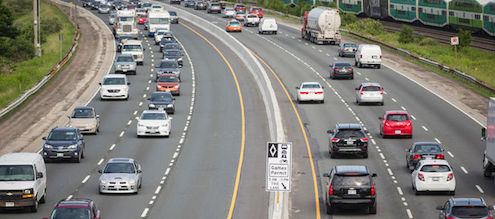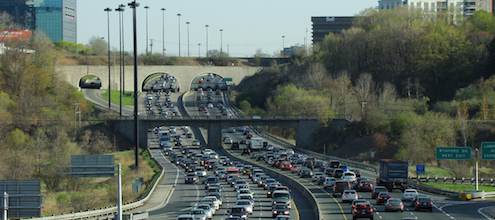
Outstanding questions on Ontario’s proposed QEW pilot project
In our recent blog on Ontario’s coming HOT lane pilot project, we congratulated Ontario on moving forward on congestion pricing policy. However, a few specific issues with the proposed Queen Elizabeth Way (QEW) pilot project remain. First, using a monthly permit approach can limit the effectiveness of policy and increase costs. It can also reduce the useful data that comes out of a pilot project (and that informs future policy) and can exacerbate fairness concerns. Second, four-years is longer than needed for such a pilot. Let’s take a closer look at these issues.
A monthly permit approach—even temporarily—limits the benefits of HOT lanes
The initial pricing structure for the proposed QEW pilot project stands out. While full pricing details are slated for spring 2016, Ontario announced that the pilot project would start with the Province issuing a limited number of monthly single driver permits (about 1000) allowing solo drivers to access the existing HOV lane. This would likely use stickers to identify permit holders. The permits would be a first step ahead of transitioning to an electronic, pay-per-use model after four or so years (likely with prices that vary in response to traffic levels). After roughly four years, the plan would also see Ontario bringing in electronically tolled—and pay-per-use—HOT lanes on parts of the 427 and 409 in the GTA.
Setting up pay-per-use is more complicated, given that it requires equipment to identify and sense each car. But the permit model has three key drawbacks that deserve further consideration.
A monthly pass can reduce effectiveness of congestion pricing
Congestion pricing works best when the price is tied to the level of congestion. All HOT lanes in operation in other jurisdictions currently charge on a per-use basis, with prices fluctuating based on congestion. The monthly permits are a blunt instrument in comparison, since they are not sensitive to the time of day or to levels of congestion. Individual drivers therefore don’t have incentives to make the choice to pay for access to the HOT lane on any one single trip (either when congestion is greatest or when reducing travel time is most valuable to that driver).
While HOT lanes in San Diego and Utah (both on stretches of US Interstate 15) used monthly permit decals for a short and pre-defined time before transitioning to electronic tolling, they began 20 and 10 years ago, respectively. It was early days for electronic tolling. Electronic tolling is now an established technology (used with success on the GTA’s 407), and despite the greater upfront expense, beginning with electronic tolling might improve first impressions of HOT lanes. Demonstrating policy success can be a powerful tool for building public support. Getting it right from the start matters.
Monthly permits could limit the useful data that the Province can collect
One of the key goals of testing policy through trials is to identify what works and what doesn’t. The full benefits of pilot projects can only be realized if they are monitored over time. Designing pilots so that the impact on congestion, and also the overall administrative costs, can be measured and assessed is key. However, monthly permits could prevent collection of real time usage information, which would be key for creating an expanded HOT lane network.
Monthly passes can exacerbate fairness concerns
Use of toll lanes is influenced by peoples’ perception of the value of their time, which is correlated to a certain degree with income. But, someone trying to get to an interview or appointment that encounters gridlock, or a parent that needs to get through traffic to pick up a child from daycare, may well feel the expense of the toll is of benefit, regardless of income. A pay-per-use system could accordingly influence decisions to pay a toll. A monthly permit, on the other hand, requires a commitment before getting into gridlock—a commitment that would prohibit some lower-income drivers. It may not be worth the risk of creating the perception among drivers that these lanes will always require a monthly financial commitment.
How long is needed for a trial?
It’s important to give people a chance to see HOT lanes in action, but the proposed implementation timeline for the QEW pilot will make for a long trial. The Toronto Star noted in an editorial that the provincial NDP and PC parties have opposed the concept, and the slow roll out increases the chances that the policy is scrapped should there be a change of government.
After a year or so, people would generally have had sufficient time to gauge the HOT lanes. The Provincial Government would likely have sufficient data on the policy to make any necessary design adjustments before choosing how to move forward with an expanded HOT lane network.
Testing the HOT lanes via pilot projects makes good sense, and indeed, one of the key recommendations in our recent report is for time-limited, reversible trial periods. Canadians don’t have experience with HOT lanes, and it’s understandable that they would want to see it in action before making up their minds. Stockholm, for example, saw support for its congestion charge grow considerably over a half-year trial period, and then ceased the policy before holding a referendum. After seeing congestion rebound, voters chose to keep the policy.
The GTA’s HOT lanes could motivate further congestion pricing in Canada
Being a first mover is not easy and Ontario deserves credit for moving forward with their HOT lane pledge. Monthly passes might be out of reach for lower income drivers who would otherwise use a HOT lane on occasion, and the timeline of Ontario’s HOT lane pilots projects is on the long side. But the Province has set the wheels in motion, and is open to comments on the QEW HOT lane pilot plan.
Taking a step back to look at the bigger picture, it’s an exciting time for smarter approaches to using our road and public transit infrastructure and cutting back on congestion. In Calgary, there appears to be increasing support for approaches such as HOT lanes and the City will surely keep tabs on developments and experience in Ontario. There is also renewed discussion of congestion pricing springing up in Vancouver, Ottawa, and Montreal. And a review of the Canada Transportation Act is underway, which could seek to provide clarity on how municipal user fees such as tolls can be tied to congestion reduction, and on enabling federal funding for congestion-pricing pilot projects.
If you haven’t yet seen our recent report on congestion pricing in Canada, check it out:
Read We Can’t Get There from Here: Why Pricing Congestion is Critical to Beating It
Transport Futures is holding an event in Toronto on HOT Lanes: Friday, January 22nd.




Comments are closed.